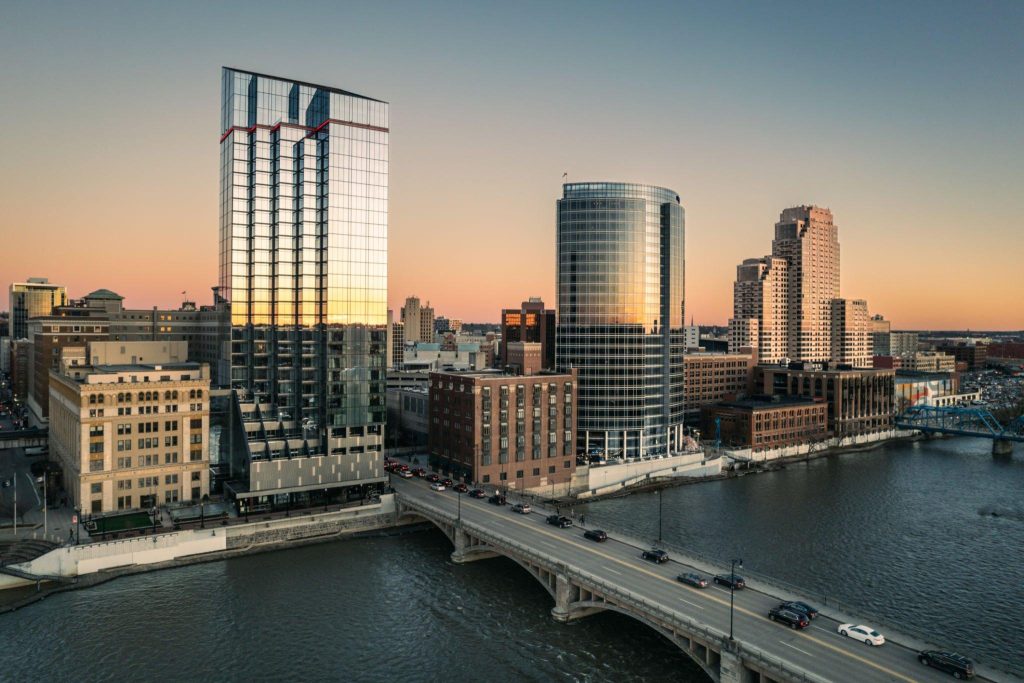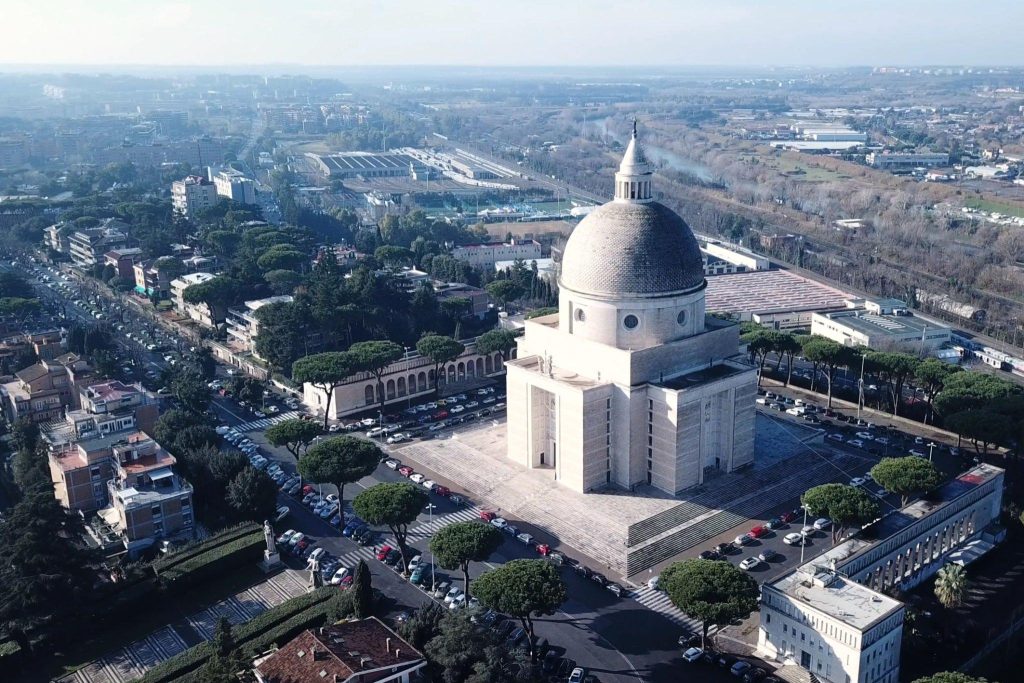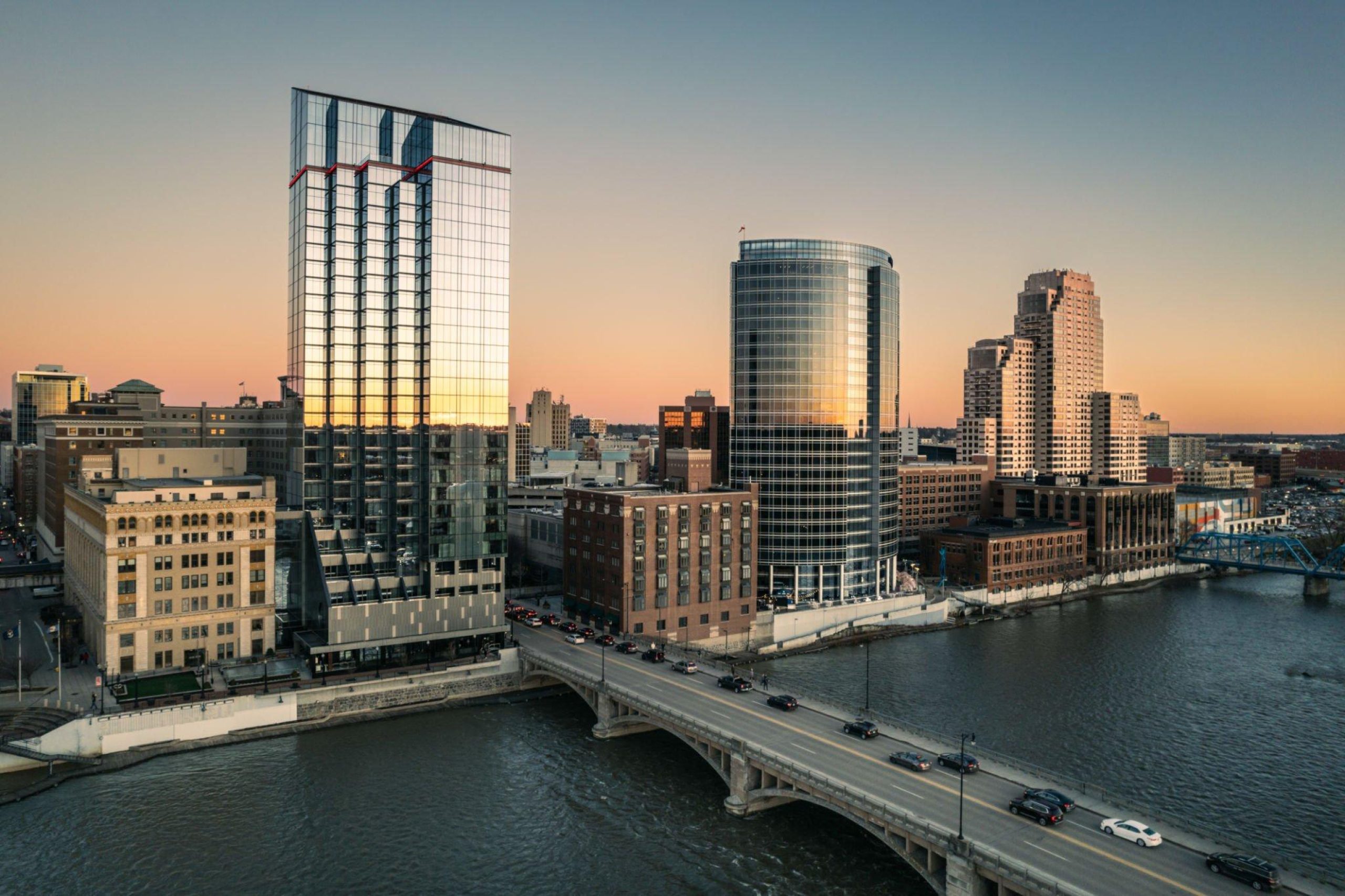
Grand Rapids, a vibrant city nestled in the heart of the Midwest, is renowned for a multitude of remarkable attributes that have collectively propelled it onto the global stage.
This thriving metropolis, situated in the state of Michigan, boasts a rich tapestry of history, culture, and innovation that have combined to shape its distinct identity and reputation. Famous for its flourishing arts scene, Grand Rapids stands as a beacon of creativity and artistic expression.
The city is perhaps best known for hosting ArtPrize, an internationally acclaimed art competition that transforms its urban landscape into an expansive gallery, attracting artists and enthusiasts from around the world. This annual event exemplifies Grand Rapids’ commitment to fostering a sense of community and engagement through the arts.
Beyond its artistic endeavors, Grand Rapids has also carved a niche in the world of craft brewing. With a plethora of microbreweries and a burgeoning craft beer culture, the city has earned the moniker “Beer City, USA.”
Its dedication to producing exceptional brews has garnered attention and accolades, drawing in visitors eager to savor the diverse and delectable flavors that the local breweries have to offer.
Moreover, Grand Rapids boasts a rich historical legacy as a pivotal center for furniture manufacturing throughout the 19th and 20th centuries. This heritage continues to resonate in the present day, with a multitude of furniture stores, galleries, and museums paying homage to the city’s enduring prominence as a hub of design and manufacturing.
If you’re interested in exploring similar historical legacies in other iconic destinations, consider embarking on some Bar Harbor adventures in Maine, a state renowned for its own unique heritage and attractions.
Contents
- 1 Symbols of Grand Rapids: Emblems of Identity
- 2 The Commission-Manager Plan: Pioneering Governance
- 3 Appointed Officials: Guiding the City’s Trajectory
- 4 Tax Base: Fueling Growth and Development
- 5 Economy: A Hub of Innovation and Commerce
- 6 Utilities: Powering the City’s Vitality
- 7 Transportation: Connecting Communities
- 8 Education: Nurturing Minds, Shaping Futures
- 9 Culture: Celebrating Diversity and Creativity
- 10 Entertainment: A Tapestry of Choices
- 11 Elected Officials: Democratic Representation
- 12 City Comptroller: Financial Stewardship
- 13 City Attorney: Legal Guardianship
- 14 Road, Rail, Air: Connecting Horizons
- 15 Conclusion
Symbols of Grand Rapids: Emblems of Identity
In the vibrant tapestry of urban life, certain cities are defined not only by their physical landmarks but also by the symbolic representations that encapsulate their essence.
Grand Rapids, a city steeped in history and innovation, proudly showcases a collection of emblems that serve as vivid reflections of its identity. From iconic architecture to cultural touchstones, these symbols tell the story of a community that has evolved while cherishing its heritage.
Nestled along the Grand River, Grand Rapids stands as a testament to the spirit of progress. The city’s skyline, punctuated by the stunning contours of architectural marvels, is a visual reminder of its evolution from a humble trading post to a bustling metropolis. Each skyscraper and historical building not only speaks to the city’s economic growth but also reflects the aspirations of its inhabitants.
At the heart of Grand Rapids’ cultural identity lies a rich artistic heritage. The city’s commitment to creativity is epitomized by the Frederik Meijer Gardens & Sculpture Park, a sprawling oasis where nature and art intertwine.
Here, sculptures from renowned artists punctuate the landscape, fostering a dialogue between human imagination and the natural world. This garden of artistic expression stands as an emblem of Grand Rapids’ dedication to fostering cultural growth and nurturing the human spirit.
The Commission-Manager Plan: Pioneering Governance
In the intricate web of governance models that exist across the world, the Commission-Manager Plan stands as a pioneering and innovative approach to local government administration. Originating in the early 20th century, this plan revolutionized the way municipalities are managed, introducing a professional and efficient system that has been widely adopted across the United States.
To explore Indiana’s distinctive traits and discover the unique aspects that make the state stand out, visit the page on Indiana’s Distinctive Traits to uncover the state’s remarkable attributes and experiences.
This article explores the Commission-Manager Plan, its history, key principles, advantages, and its continued relevance in modern governance.
The Commission-Manager Plan, also known as the Council-Manager Plan, emerged during a period of rapid urbanization and the need for more effective municipal governance.
In 1908, Staunton, Virginia, became the first city to adopt this groundbreaking system, and the idea quickly gained traction. The Commission-Manager Plan was officially endorsed by the U.S. Bureau of Municipal Research in 1913.
Appointed Officials: Guiding the City’s Trajectory

In the intricate tapestry of urban governance, appointed officials stand as key weavers, entrusted with the responsibility of shaping a city’s destiny.
From city planners and department heads to advisory board members, these individuals play a vital role in steering the trajectory of their municipalities towards prosperity, sustainability, and community well-being.
Romania’s rich history and cultural heritage also provide valuable lessons in the importance of preserving and cherishing our roots.
To learn more about Romania’s proud heritage and its contributions to the world, explore the page Romania’s Proud Heritage on Tales of Travelers.
Beyond the democratic mandate of elected representatives, appointed officials bring expertise, continuity, and specialized insight to the table, often working tirelessly behind the scenes to ensure the smooth functioning and progress of a city.
While elected officials embody the voice of the people, appointed officials contribute a different facet to the administrative framework.
With backgrounds ranging from urban planning and environmental science to finance and public health, their expertise allows cities to harness specialized knowledge in decision-making processes.
City planners, for instance, work diligently to create comprehensive development strategies that balance growth with preservation, steering cities away from haphazard urban sprawl and towards sustainable expansion.
Tax Base: Fueling Growth and Development
Taxes play a pivotal role in shaping the economic landscape of a nation, serving as a vital source of revenue for governments to fund public services and infrastructure.
The concept of a tax base, which encompasses the economic activities and assets subject to taxation, plays a pivotal role in fostering sustainable growth and development.
One example of a thriving tax base can be found in Maine’s rocky shores, known for their picturesque beauty and the diverse economic opportunities they provide.
To learn more about what Maine is known for and the role its unique features play in its tax base, check out this informative article on “Maine’s rocky shores.”
This article delves into the essence of a robust tax base, its impact on economic progress, and the strategies governments can adopt to optimize its potential for fostering prosperity.
A tax base refers to the broad spectrum of economic activities, assets, and transactions that are subject to taxation by a government. It encompasses various sources of revenue, including income, consumption, property, and wealth.
A diverse and well-defined tax base allows governments to collect funds efficiently and fairly, ensuring that the burden of taxation is distributed equitably across different segments of society.
Economy: A Hub of Innovation and Commerce
In the intricate web of global development, the economy stands as a central pillar, driving progress, shaping societies, and fueling innovation and commerce. It serves as a dynamic ecosystem where ideas, resources, and aspirations converge to create prosperity, open pathways for growth, and catalyze groundbreaking transformations. As we explore economic dynamism across various regions, it’s fascinating to examine how different locations have leveraged their unique attributes to contribute to this global phenomenon.
Utah, for instance, is renowned for its economic contributions, and its story is closely intertwined with the concept of “Famous Utah Landmarks.” These landmarks not only showcase the state’s natural beauty but also play a significant role in its economic success. To delve deeper into what Utah is known for, check out our article on “Famous Utah Landmarks.”
At the heart of a thriving economy lies the remarkable interplay between innovation and commerce. Innovation is the spark that ignites progress, and the economy provides the platform for these innovative ideas to flourish.
In today’s rapidly evolving landscape, innovation isn’t merely confined to scientific discoveries and technological advancements; it extends to novel business models, creative marketing strategies, and the reinvention of existing industries.
Entrepreneurs, startups, and established companies all contribute to the ecosystem of innovation. The economy serves as a conduit, connecting visionary minds with the necessary resources – funding, talent, infrastructure – to bring their ideas to life.
This symbiotic relationship between innovation and commerce drives the development of new products and services, improves efficiency across industries, and elevates the overall quality of life.
Utilities: Powering the City’s Vitality

In the heart of every thriving city, a complex network of utilities silently works to sustain the bustling metropolis and enable its inhabitants to lead their daily lives with comfort and convenience.
If you’re curious about the unique qualities that make cities like New Jersey stand out, you’ll discover some of Jersey’s memorable traits in our article on “Jersey’s Memorable Traits,” which delve into what New Jersey is known for.
These distinctive characteristics contribute to the city’s vibrant identity and help it rank among the most remarkable destinations.
From the moment the sun rises to long after it sets, a symphony of power, water, gas, and telecommunications systems harmonize to create an environment where modern life can flourish.
This article delves into the indispensable role of utilities in maintaining the vitality of a city and explores the intricate web of infrastructure that keeps everything running seamlessly.
Electricity, the lifeblood of the modern world, courses through a city’s veins, energizing homes, businesses, and public spaces alike. As urban landscapes continue to evolve, the demand for power grows exponentially.
The intricate dance of power generation, transmission, and distribution must be orchestrated flawlessly to ensure a continuous and reliable supply.
Renewable energy sources, such as solar and wind, are increasingly integrated into city grids, reducing the environmental impact and ensuring a sustainable future.
Transportation: Connecting Communities
Transportation, a vital component of modern society, encompasses the various systems and modes that facilitate the movement of people, goods, and services from one place to another.
Ranging from traditional methods like roads and railways to cutting-edge technologies such as electric vehicles and hyperloop systems, transportation plays a pivotal role in shaping economies and connecting the global community.
Efficient transportation networks not only enhance accessibility and mobility but also contribute to economic growth by facilitating trade and commerce.
Well-developed infrastructures, like highways and ports, can reduce transportation costs, boost productivity, and encourage business expansion.
Additionally, public transportation systems, including buses, trains, and subways, offer sustainable solutions to urban congestion and environmental concerns.
Education: Nurturing Minds, Shaping Futures
Education is the cornerstone of human progress and development. It is a powerful tool that has the ability to transform individuals, societies, and even entire nations. With the capacity to unlock human potential, education plays a vital role in shaping the course of our future.
At its core, education is about nurturing minds. It provides the opportunity for individuals to explore their interests, discover their passions, and develop a deep understanding of the world around them.
From early childhood education that lays the foundation for learning, to higher education that offers specialized knowledge and skills, the journey of education is a lifelong endeavor.
Education equips individuals with the ability to think critically, analyze situations, and solve complex problems. It fosters creativity, encourages curiosity, and instills a sense of wonder.
Through education, minds are enriched with a diverse range of ideas, perspectives, and cultures, fostering tolerance and empathy. Moreover, education empowers individuals to make informed decisions, enabling them to lead purposeful and fulfilling lives.
Culture: Celebrating Diversity and Creativity
Culture encompasses the collective beliefs, values, traditions, customs, arts, and social behaviors of a group or society. It is the fabric that binds people together, shaping their identities and guiding their interactions.
Culture is not limited to nationality or ethnicity; it can also exist within smaller communities, organizations, or even subcultures. It influences how individuals perceive the world, make choices, and communicate.
Cultural elements include language, religion, cuisine, clothing, rituals, music, dance, and art forms. These components reflect the history and evolution of a society and provide a framework for passing down knowledge and heritage to new generations. Culture is not static; it evolves over time due to interactions, innovations, and external influences.
Understanding and respecting different cultures promote diversity and enrich society. It allows for the exchange of ideas, fosters mutual understanding, and contributes to a more interconnected world.
Entertainment: A Tapestry of Choices

In a world filled with an ever-expanding array of media and experiences, the concept of entertainment has transformed into a rich and intricate tapestry of choices.
From movies to video games, books to virtual reality experiences, the possibilities for amusement and diversion seem limitless. This article delves into the multifaceted nature of modern entertainment, exploring how individuals are presented with an unparalleled range of options that cater to their diverse tastes and preferences.
Gone are the days when entertainment was a one-size-fits-all concept. Today, the landscape is teeming with a diverse collection of genres, formats, and platforms that cater to every imaginable interest.
Whether you’re a fan of heart-pounding action, mind-bending science fiction, thought-provoking documentaries, or heartwarming romances, there’s something out there that resonates with you.
Streaming services, cable networks, publishing houses, and game studios all contribute to this vast mosaic of choices, ensuring that no matter your inclination, there’s always something captivating to experience.
But what truly sets modern entertainment apart is the interactive nature it often assumes. Video games, for instance, have evolved from mere button-mashing endeavors to complex narratives that allow players to shape the outcome.
In this era of choice-driven storytelling, gamers don’t just passively observe; they actively participate in the development of the plot, making decisions that influence the game’s direction.
This interactivity extends to other media too – interactive films and books are pushing the boundaries of engagement, enabling audiences to make pivotal choices that redirect the course of the narrative.
Elected Officials: Democratic Representation
Elected officials are the cornerstone of Grand Rapids’ democratic framework. The City Commission, composed of dedicated commissioners, shapes policies and decisions that reflect the community’s aspirations and needs. Their commitment to transparent governance bolsters the city’s fame.
In a world where the principles of democracy and representation are held in high regard, the role of elected officials takes center stage. Elected officials form the backbone of democratic governance, serving as the intermediaries between the will of the people and the decisions that shape a nation’s course.
This article delves into the crucial concept of democratic representation, exploring the significance of elected officials, their responsibilities, and the challenges they face in fulfilling their roles.
City Comptroller: Financial Stewardship
In the intricate landscape of urban governance, a crucial figure stands as the guardian of fiscal responsibility – the City Comptroller. As the custodian of a city’s financial wellbeing, the City Comptroller plays a pivotal role in ensuring transparency, efficiency, and accountability in the management of public funds.
\In this article, we delve into the responsibilities and significance of the City Comptroller’s role as a financial steward, examining how their actions can shape the economic trajectory of a city.
The City Comptroller’s primary duty is to oversee the city’s financial affairs, making certain that financial operations adhere to legal and ethical standards. They are tasked with monitoring revenues, expenditures, and investments, providing a watchful eye over the public purse.
By conducting regular audits and reviews, the City Comptroller acts as a safeguard against mismanagement, fraud, and misuse of funds, ensuring that taxpayer money is put to its intended use – benefiting the city and its residents.
City Attorney: Legal Guardianship

The City Attorney safeguards Grand Rapids’ legal interests. Providing legal counsel to the city commission and other officials, this role ensures that the city operates within the bounds of the law. The city attorney’s expertise fortifies the city’s reputation for responsible governance.
Legal guardianship plays a vital role in ensuring the welfare and protection of individuals who are unable to make important decisions for themselves. The City Attorney’s office assumes a significant responsibility in managing and overseeing legal guardianship cases within the jurisdiction.
From minors to adults with incapacitating conditions, the process of establishing and monitoring guardianship arrangements demands a comprehensive understanding of the law and a commitment to upholding the best interests of the wards involved.
Road, Rail, Air: Connecting Horizons
Grand Rapids’ fame reaches far and wide through its robust transportation networks. Roadways, railways, and air travel connect the city to regional and global destinations. This accessibility fosters economic growth, cultural exchange, and tourism, enhancing the city’s renown.
In the intricate tapestry of modern transportation, the seamless integration of roadways, railways, and airways plays a pivotal role in shaping our global society.
As these diverse modes of travel converge and interconnect, they create a web of connectivity that spans continents, fosters economic growth, and facilitates the exchange of cultures and ideas.
This article delves into the significance of these three major transportation modes and their collective role in connecting horizons like never before.
Conclusion
In the vibrant tapestry of cities, Grand Rapids shines as a multifaceted gem, celebrated for its unique offerings and rich cultural tapestry. Renowned as a hub of art, culture, and innovation, this city has etched its name onto the canvas of American cities in a remarkable way.
From its world-class art museums to its burgeoning craft beer scene, Grand Rapids has carved out a distinctive identity that beckons visitors and captivates residents alike.
At the heart of Grand Rapids’ fame lies its status as a hub of creativity and artistic expression. The city’s ArtPrize event, an international art competition, draws talents from around the globe to display their creativity across its streets, squares, and galleries.
This unique event exemplifies the city’s commitment to celebrating art in all its forms, fostering an environment of cultural enrichment and engagement.
Moreover, Grand Rapids’ rise as a craft beer destination has also contributed to its acclaim. The city boasts a remarkable array of breweries, each crafting its own unique flavors and contributing to the broader tapestry of beer culture.

